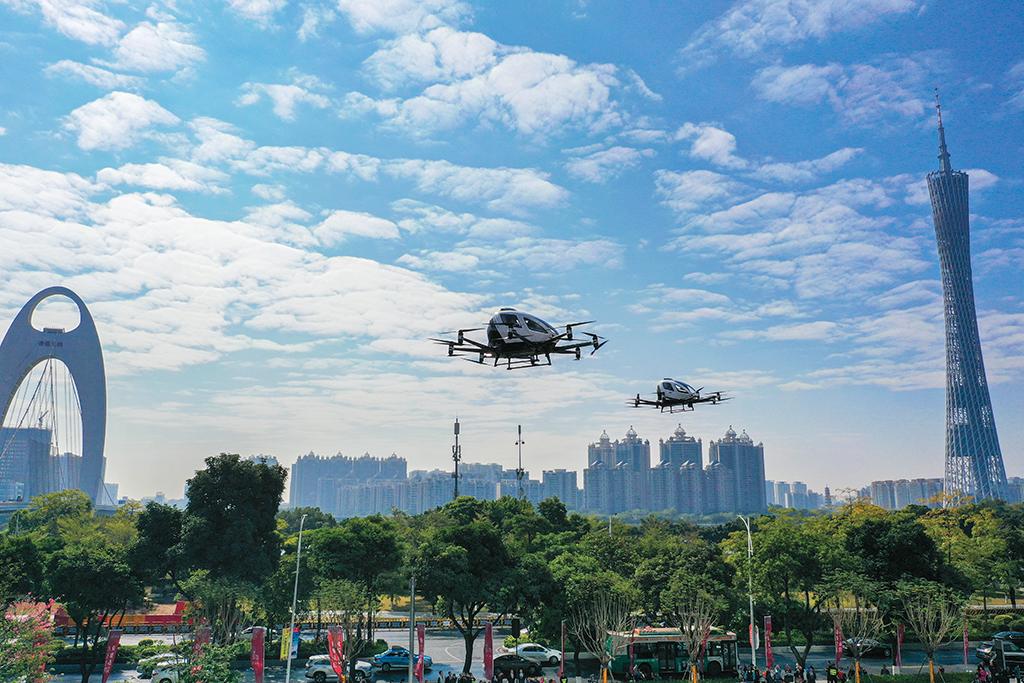
Credit: EHANGThe rubber hits the road for urban air mobility (UAM) in 2020, with demonstrations and challenges planned that will put the technology through its first realistic operational tests.
Uber plans test flights for its Elevate aerial ride-sharing service in Dallas, Los Angeles and Melbourne, Australia, using experimental electric vertical-takeoff-and-landing (eVTOL) vehicles. The company is maintaining its commitment to launch commercial service in 2023 with small fleets of certified vehicles flying a handful of routes in these pilot cities.
NASA plans an initial event in 2020 for its Grand Challenge to improve UAM safety and accelerate scalability through integrated demonstrations that bring together vehicle developers and providers of airspace operations-management services. An initial development test event is planned for July-November, paving the way for the first Grand Challenge in 2022.
And ensuring that transformative vertical flight will grab headlines in 2020, the GoFly Prize will stage its final flyoff on Feb. 29, 2020, at Moffett Field in California. Supported by Boeing, Google and Pratt & Whitney, the event is offering $2 million in prizes for building a safe, quiet, ultracompact, near-VTOL personal flying device.
The technology behind eVTOL and UAM has made significant progress since NASA engineer Mark Moore, now with Uber Elevate, produced the first concepts a decade ago. The Vertical Flight Society lists more than 200 projects worldwide, but few have any significant financial support. Even those with backing from investors or manufacturers still face technical and operational challenges.
While full-scale prototypes of at least 17 eVTOLs have so far flown, it is not yet clear which vehicles will be available and capable of conducting demonstration missions for Uber and NASA in 2020.
Only one manufacturer, China’s EHang, has begun production, shipping initial batches of its self-piloted single- and two-passenger vehicles to customers in 2019 for demonstration flights and operational trials while it works with regulators to gain certification for the multicopter eVTOLs. EHang is preparing for UAM demonstration flights in 2020 in its home city of Guangzhou.
Other developers have shown significant progress. Germany’s Volocopter in 2019 flew its prototype two-seat eVTOL over Helsinki Airport and downtown Singapore, demonstrated its VoloPort UAM terminal, unveiled its VoloCity production configuration and raised an additional $55 million.
Kitty Hawk passed the 1,000 test-flight mark with its Cora eVTOL in March, and in December unveiled a UAM joint venture with Boeing, called Wisk, that will develop and operate the two-seat self-piloted air taxi. Service is planned to begin in New Zealand, where the prototypes are being tested.
Other eVTOL vehicles being flight-tested in greater or lesser secrecy include Airbus’ four-seat ducted-rotor CityAirbus, Joby Aviation’s four-seat tiltrotor S4 and the five-seat tilt-fan Lilium Jet. The UK’s Vertical Aerospace completed flights of a second full-scale prototype, the multirotor Seraph, in 2019.
The UAM sector continues to attract investment. Airbus and Boeing are funding internal R&D as well as investing in developers of batteries and other enabling technologies. Bell is developing eVTOL cargo and passenger vehicles. Honeywell is investing heavily in developing systems for eVTOL and has partnered with Volocopter, Vertical, Pipistrel and Jaunt Air Mobility. BAE Systems is investing in UAM electrification.
UAM startups Joby, Karem, Lilium and Volocopter between them have raised more than $350 million so far, and EHang is planning a $100 million U.S. initial public offering. But the big money still lies ahead, with Lilium seeking $400-500 million in 2020 to certify and industrialize its aircraft, reports TechCrunch.
Automotive manufacturers have been significant investors in UAM, led by Daimler, Toyota and China’s Geely. South Korea’s Hyundai has formed a UAM division, and Porsche has partnered with Boeing on premium personal eVTOL. But automakers face multibillion-dollar bills to electrify their road-vehicle product lines, and whether they are willing to invest heavily in UAM going forward remains to be seen.



Ingen kommentarer:
Legg inn en kommentar
Merk: Bare medlemmer av denne bloggen kan legge inn en kommentar.